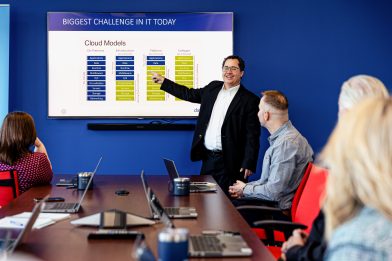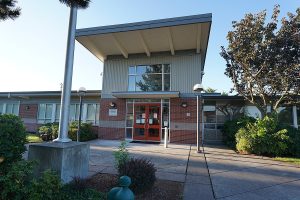Data Networks engineers, their Microsoft partners, and the VPS IT team collaborated to begin the project on time by first analyzing the current situation and planning the movement of all email, files, user accounts, and other data to the cloud, as well as the replacement of old infrastructure components. Gradually, the project team gained momentum and, by the end of 2021, had designed a process by which school district student and employee account information and other attributes would be migrated from NetIQ eDirectory (VPS’ existing Novell identity management solution) to local Microsoft Active Directory to Microsoft Azure in the cloud. Work continued until a dramatic change in approach forced the project team to assess, adapt, and overcome.
A Mid-Project Shift
In December 2021, a new Superintendent of Schools assumed responsibility for VPS. Based on his own previous familiarity and experience, and with some supportive feedback from most school district teachers and other learning staff, the Superintendent determined that Google Workspace would be the new cloud application platform rather than Microsoft 365. Of course, this was a major shift in requirements. “We supported the decision to move to Google, but it gave us quite a vector change to handle. Events like this give us all insight into who people really are, and my impression of Data Networks at that juncture was that they are caring, motivated, and diligent in reacting appropriately to change,” says Moxley.
Data Networks project management and engineers quickly grasped the ramifications of the switch to Google. New Google-centric partners were sourced and negotiated into the project scope, then Data Networks communicated the impacts of the changes to VPS and prepared an addendum to the original project agreement that fit the predictable cost increases within the budget originally agreed upon by the school board.
A key Data Networks partner rapidly joined the workstream with the ability to migrate all the user account information from local Active Directory to Google Workspace. “This was the first Data Networks project where we made a huge pivot midstream. Not only do I believe we pivoted well, but we also demonstrated we have reliable vendor partners who can respond,” says Todd Rechen, Data Networks’ lead engineer on the project.
After making all necessary adjustments with the Google Workspace solution in mind, Data Networks engineers resumed focus on finishing the project. There were still many tasks to complete with much effort required but not a lot of calendar time remaining. The team installed the Dell VxRail hyperconverged devices in place of the Hewlett-Packard hardware, virtualized additional hardware using VMWare, and created a clustered Microsoft SQL Server database in the cloud with failover in place between the live and disaster recovery environments. While rendering the new infrastructure operational ran relatively smoothly, migrating all the VPS data to the cloud proved problematic at first.
Adapting and Overcoming
At the time, VPS used NetIQ eDirectory for Novell identity management and Skyward as its student/employee information system, which had a hosted Progress database supporting it. To facilitate the new authentication architecture, all user identity data – accounts, groups, distribution lists, permissions, and the like – needed to be extracted from eDirectory and Skyward, loaded into local Microsoft Active Directory, and synced between Active Directory and Google Workspace. Also, the extracted eDirectory and Skyward data needed to be kept current with impending student changes (i.e., kids moving up one grade in the same school, other kids moving from elementary to middle school, etc.) and employee changes for the upcoming school year. Unfortunately, due to the age and proprietary nature of the existing data schemas, an off-the-shelf utility that could correctly move the data into local Active Directory did not exist. Data Networks needed to get creative to overcome this obstacle.
Lead Data Networks engineer Todd Rechen went to work, writing about 5,000 lines of code to build an application from scratch that extracted the data, mapped it to the local Active Directory schema based on the required structure, verified the migrated data, and provided easily understood error logging for any exceptions which occurred. Rechen’s program did just that, and subsequently the team completed syncing the data to Google and built the integration to synchronize changes from local Active Directory to the cloud on an ongoing basis.
The GWAVA archive of email and files presented Data Networks with another problem, according to David Hennel, Data Networks’ Director of Enterprise Services, who also managed the project: “Maintaining a thorough, accessible email and file archive is important to school districts today. The prevalence of eDiscovery as an available tool responsive to legal matters dictates this. In our case, VPS had about three times the archived data to move than we all originally anticipated, so we had a lot of archive migration work to do, and obviously needed to get it right the first time.” Data Networks enlisted Archive360, a partner specializing in such large archive migrations from sources like GWAVA, to transfer the archives into a new Barracuda Networks cloud repository.
Mission accomplished
By the summer of 2022, the project neared its go-live deadline. Data Networks worked with its trusted partners and VPS IT staff to finish uploading the student and employee data into Google Workspace, conduct final testing, and ultimately cut over the live environment to the new architecture. This was accomplished by August 2022, in time for the beginning of the new school year. Google Workspace and all its supporting components performed well and was well-received by VPS’ learning staff. As an indication of how steady the transition was, aside from the new user interfaces, all the changes and improvements made were completely transparent to the school district. Says Moxley, “Not long after the 2022-2023 school year started, our Superintendent asked me, ‘Have we completed the project? Are we live with the new technology yet? I haven’t heard anything.’ I told him yes; we’d switched over to the new systems on time. It’s an ultimate compliment to Data Networks and the rest of the project team.”
According to Moxley, “In the first month of the school year, we tripled our normal monthly help desk ticket volume, but we were expecting that and managed it. Things stabilized quickly, and now I’m in the process of hiring Data Networks on retainer to help us some more. I’m very impressed with Data Networks. Their talent, expertise, patience, communication, ability to minimize the shock of paradigm shifts, and many other traits are among the best I’ve observed in a consulting partner.”
How did such a large-scale migration project with a significant change in scope complete on schedule, satisfying all requirements? In addition to hard work and effective engagement between Data Networks, all vendor partners involved, and VPS IT staff across several time zones, Hennel attributes project success to experience: “Data Networks has a wealth of history building and supporting K-12 education technology. For VPS, we had a solid plan and our experience enabled us to identify risks in that plan, then communicate the impacts and alternative paths to get back on track. Education technology requirements are strict, but Data Networks recognizes that there’s more than one method available to get a critical task done. To complete the amount of scope, especially data migration, that we did in such a relatively short time is a testament to that.”
With the help of Data Networks-provided knowledge transfer and online learning that they continue to utilize, VPS IT staff have assumed complete responsibility for the new primarily Google, Microsoft, and Dell architecture. Statistics show positive results. For example, as of January 2023, Data Networks, and its partner Archive360 brought GWAVA archives over to Barracuda Networks at a 99.8% successful completion rate. End user feedback has all been favorable: Moxley surveyed VPS’ teachers and found that Google Workspace is not only the district’s most used application but is also the least complex.







